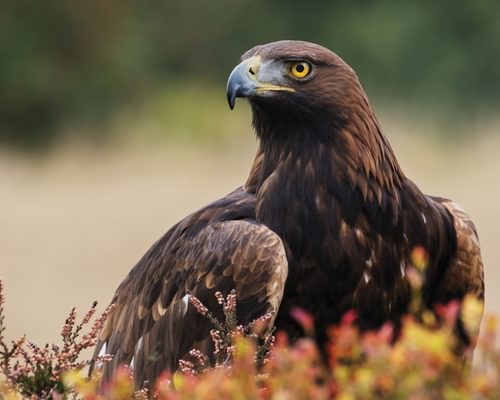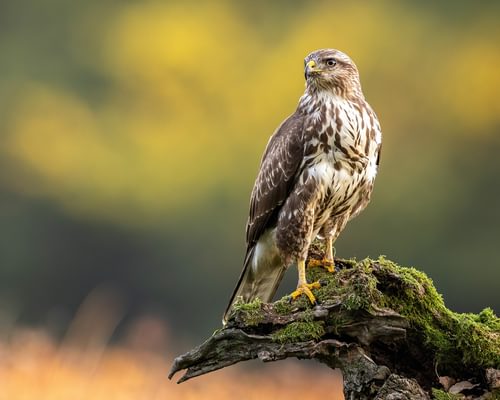White-tailed Sea-eagle
Haliaeetus albicilla
Visual Identification
Appearance
The White-tailed Eagle is a massive raptor with a broad wingspan and a large, powerful beak. Adults have dark brown plumage with a pale head and neck, contrasting with their namesake white tail. Their yellow beak and eyes stand out against their lighter head.
Females are significantly larger than males but otherwise difficult to distinguish. Juveniles are darker overall, lacking the pale head and white tail of adults. They gradually acquire adult plumage over 5-6 years, with the tail whitening last.
In flight, their broad, plank-like wings and short, wedge-shaped tail are distinctive.
Size
Length
66cm to 94cm
Wingspan
180cm to 240cm
Weight
3kg to 6.9kg
Colours
Males and females have similar plumage
Primary Colour
Brown White
Secondary Colour
Grey
Beak Colour
Yellow
Leg Colour
Yellow
Habitat and Distribution
Habitats
Woodland
Garden
Wetland
Coastal
Urban
Farmland
Grassland
Desert
Tundra
Rainforest
Mountain
Savanna
Distribution
White-tailed Eagles inhabit coastal areas, large lakes, and river valleys across a vast range from Greenland to Japan. They prefer areas with tall trees or cliffs for nesting and near productive waters for hunting.
In Europe, they range from Norway to Russia, with reintroduced populations in Scotland, Ireland, and parts of England. Some northern populations migrate south in winter, while others remain resident year-round, depending on food availability.
They've recently been re-introduced to the Isle of Wight, but otherwise, the best areas are in Scotland and include The Isle of Mull, Isle of Skye, and Lock Sunart.
Elevation Range
Sea level to 1,500 meters
Climate zones
Temperate, Subarctic
Distribution Map
This map gives you a rough idea of where you might spot a White-tailed Sea-eagle. The coloured areas show countries where these birds have been seen.
A few things to keep in mind:
- Birds might not be everywhere in the coloured areas, for example, they may be present around the coast of that country
- Where birds live can change with seasons and available food
- This map is quite simple - it doesn't show exact locations
We're working on making our maps even better! Soon, we hope to show you:
- More detailed maps for bigger countries, including state and region
- How birds move around during different seasons
Distribution by Region
Behaviour and Ecology
Bird Attributes
This feature is in beta. We'd love your feedback to improve it!
Share your thoughtsBird Attributes Explained
Our bird attributes system rates various aspects of a bird's capabilities on a scale of 0-100, based on data from field observations, scientific studies, and expert knowledge.
Attribute Categories:
- Agility: Manoeuvrability, speed, and grace in flight or movement.
- Strength: Physical power, often correlating with size and hunting abilities.
- Adaptability: Ability to thrive in various environments or changing conditions.
- Aggressiveness: Territorial behaviour and assertiveness, particularly during breeding seasons.
- Endurance: Stamina, often seen in migration patterns or foraging behaviours.
Understanding the Ratings:
- 0-20: Very Low
- 21-40: Low
- 41-60: Average
- 61-80: High
- 81-100: Very High
Remember, these attributes are relative to other bird species and don't necessarily indicate superiority.
Hover over the icon next to each attribute for more information.
Tap the icon next to each attribute for more information.
Agility
Reflects the bird's manoeuvrability, speed, and grace in flight or movement.
The White-tailed Eagle demonstrates remarkable agility for its size. Its ability to perform spectacular aerial displays during courtship, including talon-grappling and cartwheeling, showcases its impressive manoeuvrability. Additionally, its skill in low-flying hunting techniques over water surfaces further emphasises its agility.
Strength
Indicates the bird's physical power, often correlating with size and hunting abilities.
As one of the largest raptors, the White-tailed Eagle possesses formidable strength. Its ability to carry prey weighing up to 6-8 kg, although typically opting for smaller items, is a testament to its muscular power. The massive size of their nests, sometimes weighing over a tonne, also indicates significant strength.
Adaptability
Represents the bird's ability to thrive in various environments or changing conditions.
White-tailed Eagles show considerable adaptability. Their diverse diet, encompassing fish, waterfowl, small mammals, and carrion, demonstrates their ability to exploit various food sources. Their successful reintroduction and recovery across different habitats, from coastal areas to inland lakes, further illustrates their adaptability.
Aggressiveness
Measures the bird's territorial behaviour and assertiveness, particularly during breeding seasons.
While not overly aggressive towards humans, White-tailed Eagles are formidable predators. Their powerful hunting abilities and role as apex predators in their ecosystems indicate a moderate to high level of aggression when necessary, particularly in hunting and defending their territory during breeding season.
Endurance
Reflects the bird's stamina, often seen in migration patterns or foraging behaviours.
The White-tailed Eagle's endurance is impressive. Their ability to soar for hours on thermal currents demonstrates excellent stamina. Additionally, their long lifespan of over 25 years in the wild, with some individuals reaching 36 years, suggests robust endurance and resilience to environmental challenges.
Diet
These eagles are opportunistic predators and scavengers. Their diet primarily consists of fish, waterfowl, and seabirds, but they also take small mammals and carrion. They often hunt by flying low over water, snatching fish from the surface with their powerful talons.
They also hunt water birds and seabirds, either in flight or on the water. Eggs and chicks are taken in the breeding season, and they will also steal the prey from other fishing birds like the Osprey and Heron.
Behaviour
White-tailed Eagles are often seen perched prominently on coastal cliffs or tall trees, scanning for prey. They are powerful fliers, capable of soaring for hours on thermal currents.
During courtship, pairs perform spectacular aerial displays, including talon-grappling and cartwheeling through the air.
Vocalisation
White-tailed Eagles have a range of vocalizations but are generally quiet outside the breeding season. Their most common call is a series of yelping or barking sounds, described as 'kya-kya-kya' or 'gak-gak-gak'. During courtship, they produce softer, mewing calls.
Males and females produce different notes, and the female has a deeper voice. Apart from courtship, these birds also call in alarm or warning if their nest is approached.
Nesting & Breeding
White-tailed Eagles form monogamous pairs and often mate for life. Breeding begins in late winter, with elaborate aerial displays strengthening the pair bond.
Nests are massive structures of sticks built in tall trees or on cliff ledges. They are reused and added to each year, potentially reaching 2 meters wide. Females typically lay 1-3 eggs, which are plain white.
Both parents incubate the eggs for about 38 days. Chicks fledge after 10-11 weeks but remain dependent on their parents for several months, often staying in family groups until the next breeding season.
Conservation and Status
Global Conservation Status
White-tailed Eagles have recovered significantly from near-extinction in much of Europe due to intensive conservation efforts.
Reintroduction programmes, particularly in the UK and Ireland, have been successful. However, they still face threats from habitat loss, pollution, and illegal persecution in some areas.
Birdwatching Tips
- Look for them near large bodies of water, especially coastal areas and inland lakes.
- Scan tall trees and cliffs for perched birds.
- Watch for their distinctive silhouette in flight: broad wings held flat and a short, wedge-shaped tail.
- In the UK, Scotland's west coast and islands are prime viewing locations.
- Be patient and use a spotting scope for distant observations.
- The White-tailed Eagle is only likely to be confused with the Buzzard and the Golden Eagle. Buzzards are much smaller birds, with five (not six or seven) prominent primary feathers visible at the end of each wing when soaring. The Golden Eagle is very similar-sized but more shapely and longer-tailed in flight and shows a much smaller head when perched.
Additional Information
Quick Facts
Other names:
Sea Eagle, Erne
Family:
AccipitridaeAverage Lifespan
20 to 25 years
Max Lifespan
42 years [4]
Predators
Adult White-tailed Eagles have few natural predators. Eggs and chicks may be vulnerable to other large raptors, corvids, and mammalian predators like pine martens.
Did You Know?
- White-tailed Eagles can live for over 25 years in the wild, with the oldest recorded individual reaching 36 years.
- Their nests are among the largest of any bird, sometimes weighing over a tonne.
- They can carry prey weighing up to 6-8 kg, though they typically take smaller items.
- Skye and Frisa are a pair of eagles that demonstrate the devotion of their species. These two birds are the oldest White-tailed Eagle couple in the United Kingdom and have been together since 1997!
- They are the largest raptor found in the UK.
Similar Birds
References
- 1 2 3
website: BirdLife International. 2021. Haliaeetus albicilla. The IUCN Red List of Threatened Species 2021: e.T22695137A206723035.
View source - 4
website, 2000: Carey and Judge, Longevity Records: Life Spans of Mammals, Birds, Amphibians, Reptiles, and Fish
View source
Share Your Feedback
We value your opinion! Let us know what you think about this bird page.

